Surrounding the forest areas of Aravali hills around Kumbhalgarh Fort and Ranakupur temple, Kumbhalgarh Wildlife Sanctuary is located in south-central Rajasthan, India. It was notified as a wildlife Sanctuary covering 610.528 Sq. km area of three districts namely Udaipur, Rajsamand and Pali in 1971 vide Govt. of Rajasthan Notification No. F/C (2) Rev./ F/ 7 dated 13th July, 1971. The sanctuary is spread over four ranges within the Aravalli hills: the Kumbhalgarh range, the Desuri range, the Sadri range, and the Bokhada range. It derived its name from the historic Kumbhalgarh Fort. There are as many as 24 villages within the Kumbhalgarh Wildlife Sanctuary and 138 villages within the zone of influence of the Sanctuary.
Kumbhalgarh Wildlife Sanctuary provides an ideal habitat for Herbivores, Carnivores, and various arboreal and water birds. The wildlife in the sanctuary includes Sloth Bear, Indian Hare, Wild Boar, Four Horned Antelope, Fox, Grey Jungle Fowl, Wild Cat, Jackal, Porcupine, Blue Bull, Leopard, Striped Hyaena, Civet, Wolf, Sambar, Langur, Mongoose, Chinkara, Crocodile, and more. In the 2004 census carried out in the Sanctuary, the species of Desert Cat & White build Black Tit were reported first time.
Kumbhalgarh Wildlife Sanctuary can be explored by taking a jeep safari, trekking, or riding a horse.
Kumbhalgarh Wildlife Sanctuary Boundary
Kumbhalgarh Wildlife Sanctuary is in a fragile ecosystem of the Aravalli hills, just 80 km north of the beautiful Lake City, Udaipur. Geographically, the sanctuary is situated between 73°02′ – 73°30′ E longitude and 25°0′ – 25°40′ N latitude. The Sanctuary covering an area of 610.528 sq. km comprises 35 forest blocks within the limits of Rajsamand, Pali, and Udaipur districts in Rajasthan.
For effective management, Kumbhalgarh Wildlife Sanctuary is divided into four ranges: Range Bokhara (3 sections, 11 beats), Range Sadari (5 sections, 5 beats), Range Desuri (5 sections, 5 beats), and Range Kumbhalgarh (3 sections, 5 beats). In total, the sanctuary has 16 sections and 35 beats.
District Wise area of Kumbhalgarh Wildlife Sanctuary
| SL. No. | District | R.F. | P.F. | Total (Area in Hectares) |
| 1. | Pali | 34174.01 | 289.08 | 34463.09 |
| 2. | Rajsamand | 13765.92 | 745.93 | 14511.85 |
| 3. | Udaipur | 5906.75 | 6171.11 | 12077.86 |
| Total | 5906.75 | 7206.12 | 61052.8 ha. (610.528 Sq. km) | |
The boundaries of Kumbhalgarh Wildlife Sanctuary are defined as follows:
- East: The sanctuary is bordered by the eastern boundary of the Reserve Forest of Bhim and Kumbhalgarh ranges.
- West: It extends to the western boundary of the Reserve Forest of Sadri and Desuri ranges.
- North: The northern boundary is marked by the Diwer-Kot Road.
- South: The southern boundary of the sanctuary is the Padarada and Bijapur Forest Blocks of the Kumbhalgarh and Sadri ranges.
The Eco-Sensitive Zone (ESZ) around Kumbhalgarh Wildlife Sanctuary extends 5 kilometers from its boundary, except in the following areas:
- North: Where the sanctuary shares a boundary with Raoli Todgarh Sanctuary, the ESZ is zero.
- West: Around the municipal limits of Sadri town, the ESZ is 500 meters from the sanctuary.
Kumbhalgarh Wildlife Sanctuary Map
Below is the Kumbhalgarh Wildlife Sanctuary map located in Rajasthan’s Aravalli Range, showing its boundaries and Kumbhalgarh Fort, a UNESCO World Heritage Site
Villages and Tribal Rights in Kumbhalgarh Wildlife Sanctuary
24 villages within the Kumbhalgarh Wildlife Sanctuary have a similar social and cultural structure, with inhabitants primarily belonging to tribal communities such as Bhil, Bhil Meena, and Garasia. The Rajputs, Rebari, and Meghwal communities are also present in significant numbers across several villages. Each village comprises multiple “Phalas,” inhabited by various clans.
Earlier, the rights of villagers in the sanctuary area were settled for Reserved Forest Blocks, reaffirmed by the Collectors of Udaipur, Rajsamand, and Pali under the provisions of Sections 19-25 of the Wildlife (Protection) Act, 1972. However, following Supreme Court orders in IA No 548 and orders dated 11th May 2001, villagers are currently unable to exercise these established rights within the sanctuary.
Villages inside the sanctuary:
- Range Kumbhalgarh (District: Rajsamand): Kotra (Pokaria), Roopnagar, Boitara, Nadiya, Miyawa, Charan Beri, Thali, Pada ka Padav, Satpalia, Bhagwanpura. (10 villages)
- Range Bokhada (District: Udaipur): Majwara, Kura, Kagarwadra, Sili, Panchbor, Balia, Nani, Paba, Pipalsari, Mal. (10 villages)
- Range Sadri (District: Pali): Pipala, Korwa. (2 villages)
- Range Desuri (District: Pali): Kharni Takri, Garasia Colony. (2 villages)

History of the Kumbhalgarh Wildlife Sanctuary
The history of the Kumbhalgarh Wildlife Sanctuary illustrates how the Raika community including local pastoralists and other herders have gradually been deprived of their customary rights over time.
- Early 20th Century:
- Until the early 20th century, the land below Kumbhalgarh Fort was a popular hunting ground for the Maharajah of Jodhpur.
- Local herders, especially the Raika community, had grazing rights on this land, known as ‘gudara’.
- 1884-1887:
- In 1884, Assistant Conservator of Forest Ajmer-Marwar assessed the forest’s commercial value.
- By 1887, the forest’s ownership was transferred to the state.
- Understanding the economic importance of pastoralism, the Maharajah ensured the Raika community retained their grazing rights.
- 1963:
- The official grazing fee for camels was set at ₹ 5 per head.
- 1971:
- Kumbhalgarh forest was declared as Kumbhalgarh Wildlife Sanctuary under the Rajasthan Wild Animals and Birds Protection Act 1951 vide Govt. of Rajasthan Notification No. F/C (2) Rev./ F/ 7 dated 13th July, 1971.
- This move aimed to protect wildlife like sloth bears, hyenas, sambhar, leopards, wolves, and grey jungle fowl.
- 1990:
- The Chief Conservator of Forest and Wildlife upheld the Raika’s grazing rights.
- 1998:
- The Collector of Pali district confirmed that the rights established at the time of the forest’s constitution would continue.
- 1999:
- The Forest Protection Committee of Rajasthan prohibited grazing in the Kumbhalgarh Wildlife Sanctuary (KWS).
- 2002-2003:
- A petition was filed in Rajasthan High Court to maintain the Raika’s grazing rights.
- In 2003, the High Court allowed the Raika from neighboring villages to graze their animals in KWS.
- 2004:
- The Central Empowered Committee (CEC) requested strict adherence to the Supreme Court’s order, forbidding the removal of dead or dying trees and grass from any national park or sanctuary.
- The Rajasthan Forest Department stopped issuing grazing permits despite the 2003 High Court order upholding Raika grazing rights.
- 2006:
- The Raika Sangarsh Samiti sought clarification from the CEC and filed another petition in Rajasthan High Court.
- The High Court referred to the CEC’s 2004 letter but allowed Raika to seek further clarification from the Supreme Court.
- On 22 February 2006 the Raika applied to the Supreme Court to clarify their traditional grazing rights.
- The Chief Wildlife Warden recommended stopping grazing in KWS to protect the Aravalli biodiversity.
- The Raika withdrew their case due to lack of resources.
- 2006:
- The Indian Parliament passed the Scheduled Tribes and Other Traditional Forest Dwellers (Recognition of Forest Rights) Act, 2006 (FRA).
- The FRA aimed to correct historic injustices and provide access and use rights to traditional forest users, including seasonal pastoralists like the Raika.
- The Raika filed claims for Community Forest Rights, but the authorities did not process these claims.
- 2012:
- It was announced that KWS would be turned into a National Park, leading to protests from surrounding villages.
- The issue was shelved with a change in the state government.
- 2019:
- Kumbhalgarh Wildlife Sanctuary was again notified as a National Park, prompting 41 villages in Pali district to raise formal objections.
- The issue lay dormant but resurfaced in 2020 with plans to designate the area around Kumbhalgarh Wildlife Sanctuary (KWS) as an Eco-Sensitive Zone.
- 2020:
- The notification dated New Delhi, 18th June 2020, declares that the KWS Eco-Sensitive Zone encompasses the periphery extending up to 5.00 km from the sanctuary boundary with exceptions: zero near Raoli Todgarh Sanctuary in the north and 500 meters around Sadri town’s municipal limits on the western boundary.
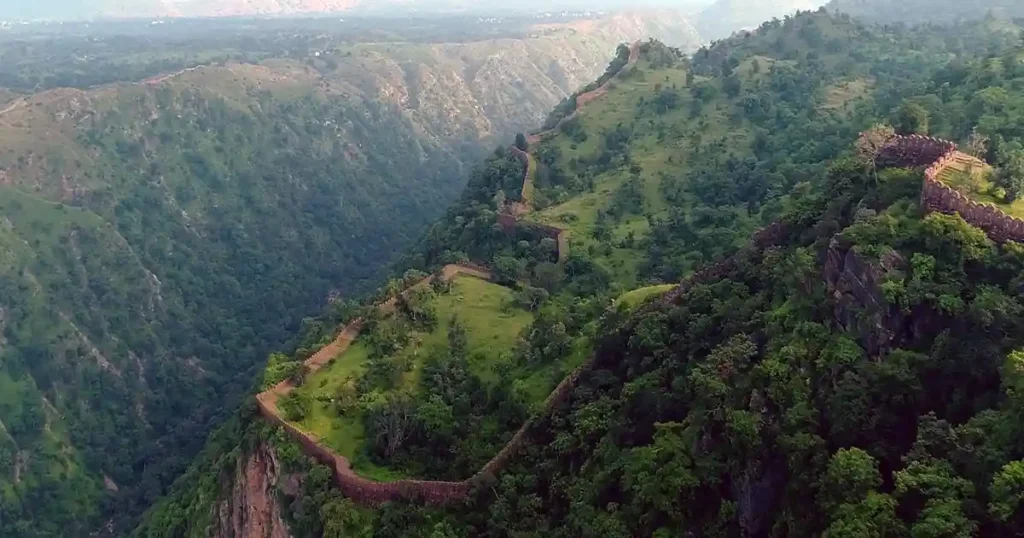
Geography of Kumbhalgarh Wildlife Sanctuary
The geography of Kumbhalgarh Wildlife Sanctuary is unique, lying between the hilly forests of the Aravalli hills varying from 275m to 1155 m in altitude, and the Thar Desert in the west. The Kumbhalgarh hills act as a natural barrier, stopping the desert from spreading eastward. A major attraction for tourists here is the Kumbhalgarh Fort, which sits atop one of the hills.
The sanctuary’s landscape is varied. The eastern part has hills ranging from 500 to 1300 meters high, while the western part borders the Marwar plains. This mixture of landscapes makes the sanctuary special. Additionally, it marks a dividing line between two major watersheds in India. The eastern section is the starting point for the Banas River, which flows into the Bay of Bengal. Meanwhile, rainwater from the western slopes forms small rivers like Sukdi, Sumer, Mithdi, and Kot, all of which are tributaries of the Luni River that eventually flow into the Arabian Sea.
The soils in the sanctuary are generally thin and mostly sandy loam, with the base rocks being mainly metamorphic from the Archean era. The topography of Kumbhalgarh Wildlife Sanctuary can be divided into hills, piedmont (foothills), and plains. Much of the plains area has been used for farming.
The Kumbhalgarh hills have rugged topography and steep slopes, causing rapid rainwater runoff. This makes the sanctuary area vulnerable to soil erosion and less water conservation.
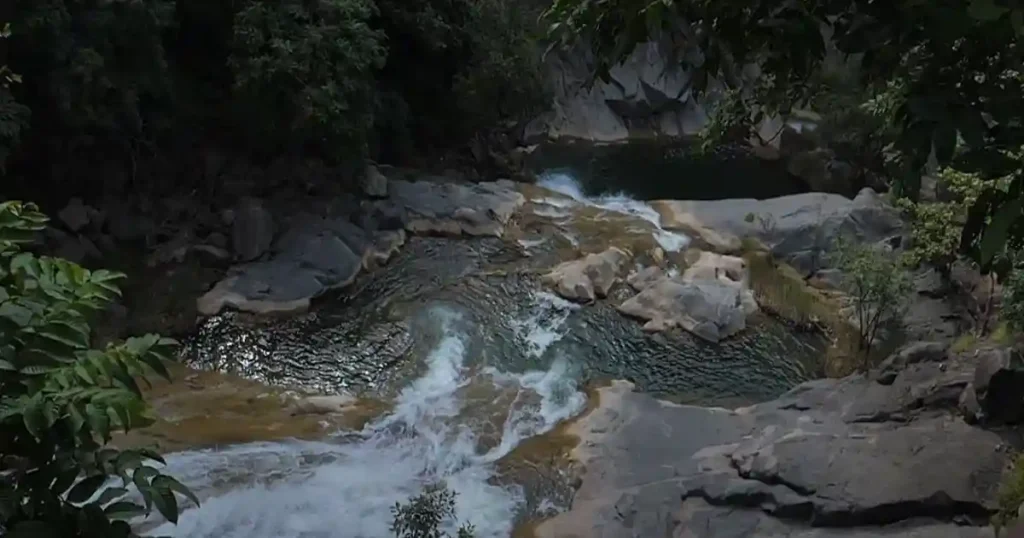
Climate of Kumbhalgarh Wildlife Sanctuary
The climate in Kumbhalgarh Wildlife Sanctuary is influenced by where it sits in the Aravalli Range near the Thar Desert. It has a semi-dry climate, like much of Rajasthan.
From March to June, it gets really hot, sometimes over 40°C (104°F), because it’s close to the desert. During summer the temperature in the sanctuary is more than 30°C average and may rise to 48°C.
The monsoon season comes in July and lasts until September. This is when most of the rain falls each year. The rain is really important for the plants and animals that live there. Normally, the sanctuary gets an average annual rainfall is 725mm, with a maximum of 950mm and a minimum of 403mm, but it can change depending on the hills and valleys.
In the winter, from November to February, the weather is mild and nice, with temperatures between 10°C to 25°C (50°F to 77°F). Many tourists visit during this time to enjoy the sanctuary in cooler weather.
Kumbhalgarh Hills: Rivers, Dams, and Irrigation
The Kumbhalgarh hills serve as a vital catchment area for numerous rivers and streams. Water runoff from the Kumbhalgarh catchment is channeled through 78 streams, eventually merging into 16 major rivers, including the Bhatund, Sai, Satpalia, Kot, Sumer, Sukri, Maghai, Lunawa, Mithadi, and Jawai.
A total of 23 dams, such as Sonwa, Jawai, Latada, Sadra, Prithvisagar, Sai, Hemawas, Mandigarh, Mithdi, Nalwania, Seli, Rajpura, and Hariom Sagar have been constructed on these rivers originating from the Kumbhalgarh hills. These dams not only provide drinking water to the people and livestock in the Jodhpur, Pali, and Jalore districts but also irrigate 80,000 hectares of agricultural land in these areas.
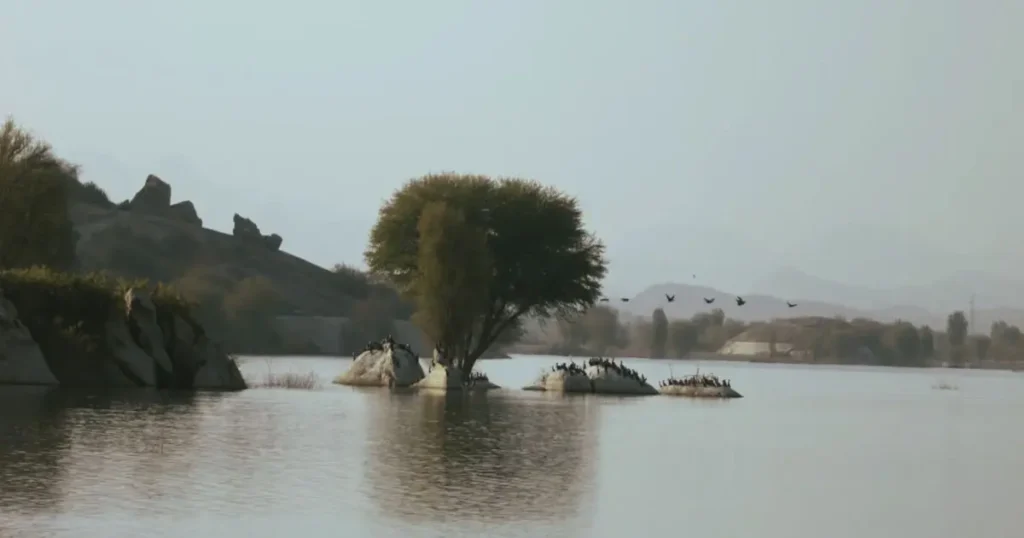
Forest and Animals in Kumbhalgarh Wildlife Sanctuary
Kumbhalgarh Wildlife Sanctuary is rich in floral and faunal diversity along with many historical and religious sites situated within its boundaries. The Sanctuary is an ideal habitat for many wild animals and more than 200 species of terrestrial, arboreal, and water birds. The wide range of climatic conditions along with great altitudinal variations provide different microhabitats.
1. Forest:
The types of plants and trees found in the Kumbhalgarh Wildlife Sanctuary are primarily determined by the combined effects of soil (edaphic factors) and climate. These forests have reached a stable, mature stage of ecological succession, known as the climax stage, where the ecosystem is in balance with the prevailing soil and climate conditions.
As per Champion & Seth’s classification, the forests of this sanctuary can be sub-classified as Group 5 Tropical Dry deciduous forests, Subgroup 5 B – Northern tropical dry deciduous forest.C2 – Northern tropical dry mixed deciduous forest.
The degraded stages of tropical dry deciduous forests exist in the sanctuary, classified as DS1 – Dry deciduous scrubs, DS1 – Anogeissus pendula scrub, E2 – Boswellia forests, E5- Butea forest, E8- Saline Alkaline Scrub savannah, E9 – Dry Bamboo Brakes.
Dhok (Anogeissus pendula) is mostly gregarious in the sanctuary area and is found mixed with various other species such as Anogeissus latifolia, Salar, Godal, Semal, Saijana, Khirni, Anogeissus sericea, Umb, Khair, Ber, Aritha, Kadaya, Jhinjha, Kemda, Ronjh, Timru, Kumtha, Pipal, Bargad, Tambolia, Bahera, Barna, Dhaman, Ghittor, Gugal, Kolai (Dichrostachys cinerea), Neem, Shirdia (Holoptelea integrifolia), Kalia, Jamun, Sawan, Rohini, Dhak, Ardu, Gular, Imli, Khajur, Agnia (Bridelia squamosa), and Vilayati Babul.
The undergrowth mainly consists of species like Jharber, Ardusa, Adhasisi, Dasan, Dhaori, Dholekan, Kadda, Gagan, Frangen, Kanter, Maror phali, Negad, Subpan, Sitraval, Thor, and Murali.
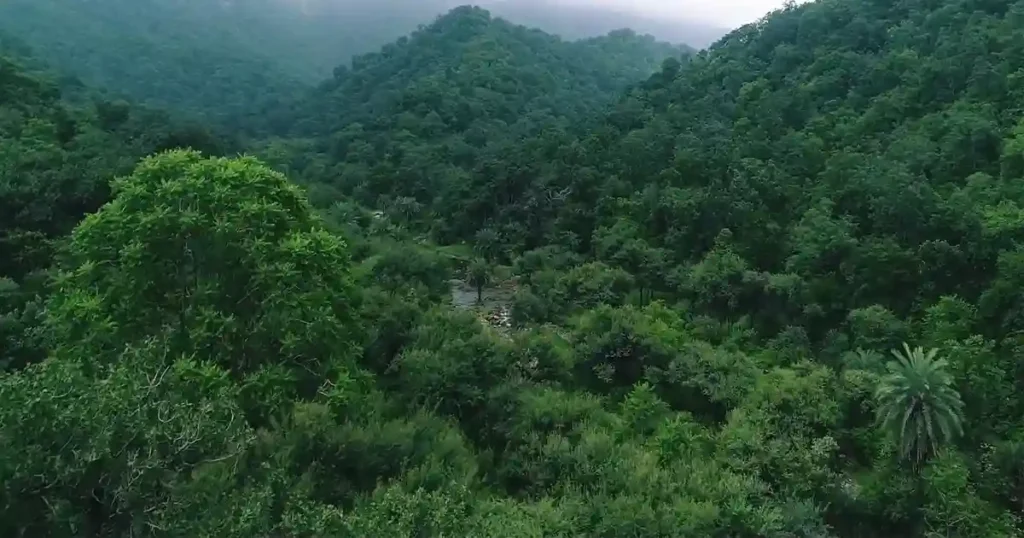
2. Animals:
In 2006, the census data showed there were about 32 tigers, which grew to 69 by 2018 in Kumbhalgarh Wildlife Sanctuary. It has a good population of Antelope (Chowsingha) and Indian Gazella (Chinkara) along with a rich floral & faunal variety of Aravalli hill ranges.
Mammals:
The major mammals recorded in the Sanctuary are wild boar, grey musk shrew, bat, flying fox, panther, common langur, striped hyena, jungle cat, five-striped palm squirrel, Indian pangolin, Indian fox, common mongoose, ruddy mongoose, house rat, blue bull, Indian hare, Indian porcupine, chinkara, jackal, Indian small civet, toddy cat, sloth bear, etc.
Amphibians:
The major amphibians found in the Sanctuary include the Indian bullfrog, skipper frog, cricket frog, Indian balloon frog, common toad, and marbled toad.
Reptiles:
Among reptiles, the Sanctuary is home to the John sandboa, common skink, checkered keelback, buff-colored keelback, rat snake, house lizard, starred tortoise, flapshell turtle, garden lizard, common Indian krait, Russell’s viper, Indian chameleon, Indian cobra, fan-throated lizard, monitor lizard, common kukri snake, green keelback snake, and tree snake.
Fishes:
The diverse fish population includes katla, rohu, grigal, mahseer, putthi, sarsi, lanchi, singhara, kater, sanwal, singhi, bam, suiya, baata, dudhia, chaal, and kalot.
Invertebrates:
Invertebrates in the Sanctuary include bhanwar (Apis dorsata and Apis indica), tannin (Cicada species), and alsiya (Pheretima posthuma).
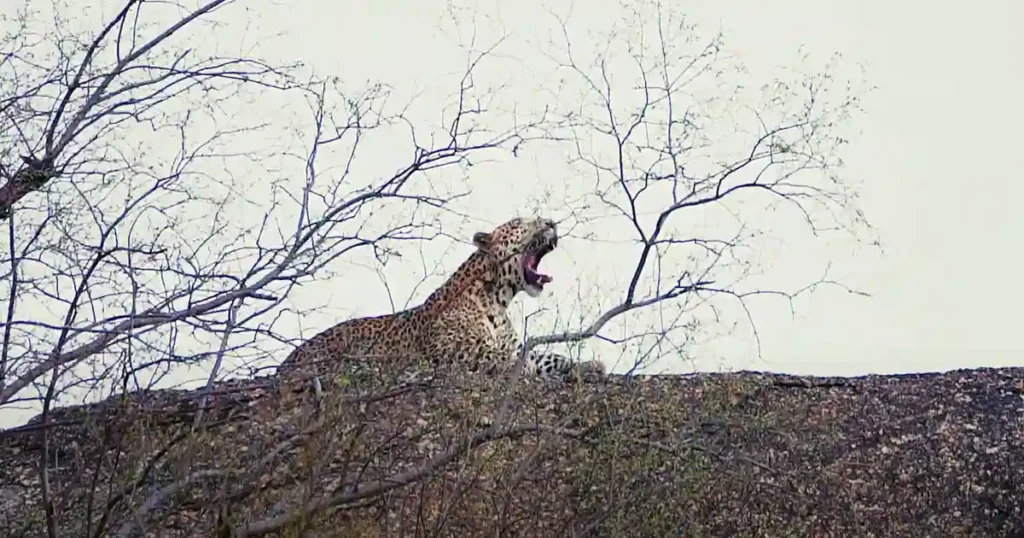
3. Birds
A total of 201 species of birds belonging to 61 families have been recorded in the Kumbhalgarh Wildlife Sanctuary until August 2001, with 72 bird species sighted at Mount Abu, the highest altitude in the Aravalli region with good rainfall and forest cover.
Out of the 201 bird species found in the sanctuary, eight are listed in “Threatened Birds of the World” (Birdlife International, 2000). Among these, Gyps bengalensis and G. indicus are Critically Endangered, Sarcogyps calvus and Mycteria leucocephala are near threatened, and Grus antigone, Rynchops albicollis, Parus nuchalis, and Estrilda formosa are Vulnerable. Parus nuchalis is endemic to India.
During normal rainfall years, when all dams and water bodies in and around the sanctuary reach full capacity, food is abundant (aquatic and terrestrial) for both resident and migratory birds. Moreover, the presence of large trees, rocks, cliffs, and small islands in the reservoirs provides good safe roosting sites, contributing to the area’s attraction of residents as well as migratory birds.
The important birds found in the Sanctuary include quail, Indian peafowl, ruddy shelduck, gadwall, spot-billed duck, teal, northern pintail, northern shoveller, yellow-crowned woodpecker, black-rumped flameback, coppersmith barbet, Indian grey hornbill, hoopoe, kingfisher, pied kingfisher, green bee-eater, pied cuckoo, Asian koel, greater coucal, rose-ringed parakeet, house swift, spotted owlet, rock pigeon, yellow-footed green pigeon, laughing dove, spotted dove, moorhen, coot, green sandpiper, wood sandpiper, little ringed plover, red-wattled lapwing, and river tern.
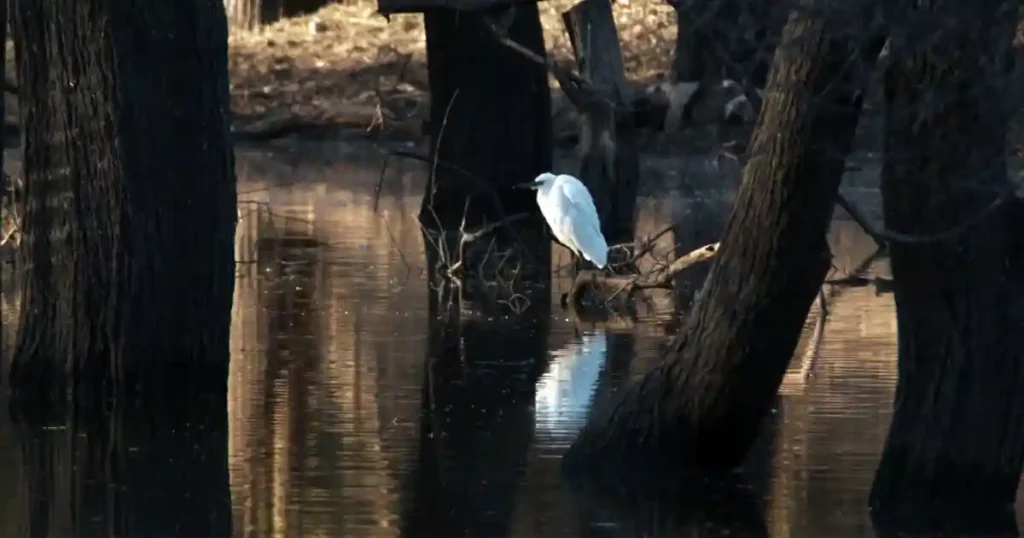
What you will see in Kumbhalgarh Wildlife Sanctuary
Along with diverse flora and fauna, there are many historical and religious places to visit inside the Kumbhalgarh Wildlife Sanctuary like Kumbhalgarh Fort, Parashram Mahadev Temple, Muchala Mahavir Jain Temple, Ranakpur Jain Temple, etc. which further increase the significance of this sanctuary. A sizeable number of tourists, both domestic and international, visit the sanctuary every year.
Kumbhalgarh Fort
Kumbhalgarh Wildlife Sanctuary is famous for the historic Kumbhalgarh Fort, also known as the Great Wall of India, from which it derives its name. It is also renowned as a natural home to numerous wild animals and more than 200 species of terrestrial, arboreal, and water birds.
Kumbhalgarh Fort (Lat. 25º 09′ N; Long. 73º 36′ E) is located at the second highest top on the westerly range of Aravalli Hills in the Kelwada tehsil of Rajsamand district in Rajasthan. It is the second most important fort in Rajasthan, built by Rana Kumbha between AD 1443 and 1458, under the architect Mandan. The fort was built on the site of an older castle from the second century BC, linked to Jaina prince Samprati.
It was declared a UNESCO World Heritage Site in 2013. The Fort is full of historic events and the second largest wall in the world spanning 38 km after the Great Wall of China, a major attraction for tourists.
Rana Fateh Singh (1885-1930 AD), one of the greatest builders, constructed the Badal Mahal inside Kumbhalgarh Fort. Key buildings within the fort are Kumbha Palace, Badal Mahal, Jain temples, Brahmanical, and water reservoirs, baoris, and chhatris.
The following are some important monuments inside the fort:
1. Gateways of Kumbhalgarh Fort:
The fort is accessed from the south through a gate called Aret Pol, followed by gates known as Halla Pol, Hanuman Pol, Ram Pol, and Vijay Pol. Hanuman Pol is notable because it houses an image of Hanuman that Rana Kumbha brought from Mandavpur.
To reach the palatial complex at the top, one must pass through three more gates: Bhairon Pol, Nimboo Pol, and Paghra Pol. There is another gate on the east side called Danibatta, which connects the Mewar region with Marwar.
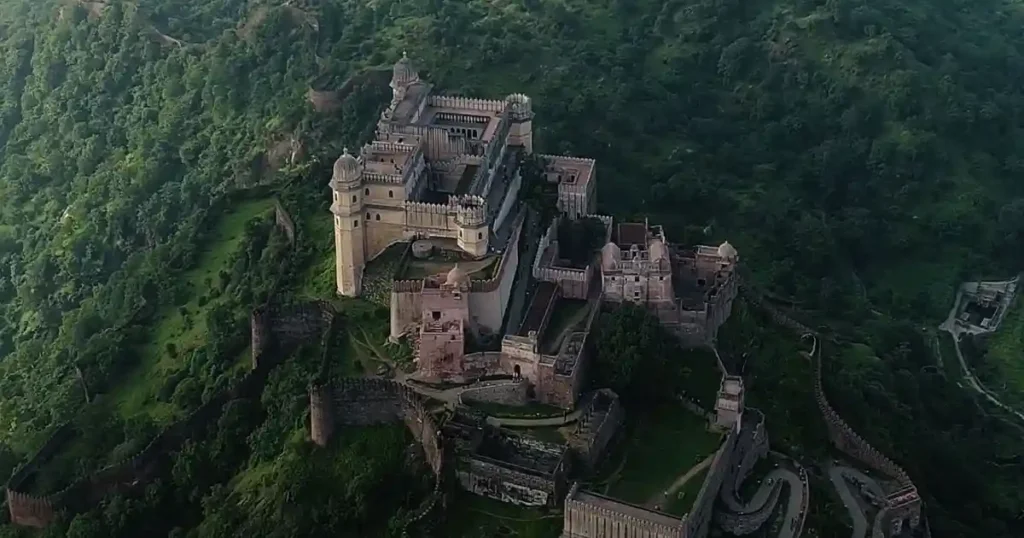
2. Ganesh Temple:
The Ganesh temple is located along the road to the palaces. It was built during Maharana Kumbha’s reign. According to an inscription on Kirttistambha at Chittaurgarh Fort, Rana Kumbha installed a statue of Ganesha in this temple
3. Vedi Temple:
The Vedi Temple was constructed by Rana Kumbha in 1457 AD for rituals performed after the fort was completed. It is a double-storeyed building on a high platform, facing west. The temple has an octagonal layout with thirty-six pillars supporting its domed ceiling. To the east of this temple is a triple-shrine temple dedicated to goddesses.
4. Neelkanth Mahadev Temple:
This temple was built in 1458 AD and is located to the east of the Vedi shrine and enshrines a Siva in the garbhagriha. It is built on a raised platform and accessible from the west by way of a set of stairs. The temple consists of a sanctum and an open pillared mandapa surrounding it. The shrine has entrances from all four directions. An inscription on the western gate’s left pillar notes its renovation by Rana Sanga.
5. Parsvanatha Temple:
The temple wad built by Nar Singh Pokhad in 1451 AD (Vikrama Samvat 1508), contains a three-foot-high idol of the Jain Tirthankara Parsvanatha.
6. Bawan Devi Temple:
This famous Jain shrine is named for the fifty-two (bawan) smaller shrines built around the main one. The larger shrine comprises a sanctum, antarala, and an open mandapa, with an image of the Jain Tirthankara carved on the doorway. The smaller shrines do not contain idols.
7. Golerao Group of Temples:
Adjacent to the Bawan Devi Temple, the Golerao group includes nine shrines within a circular wall adorned with carved sculptures of deities. Architecturally attributed to Rana Kumbha’s era, one sculpture bears an inscription from V.S. 1516 (AD 1459) mentioning Govinda.
8. Mamadeo Temple:
Also known as Kumbha Shyam, this temple comprises a flat-roofed sanctum and a pillared mandapa. An inscription by Rana Kumbha, detailing the history of Kumbhalgarh, is affixed to this temple. Numerous carved idols of gods and goddesses were found within its premises.
9. Pitalia Dev Temple:
This east-facing Jain shrine in the northern part of the fort was built by Pitalia Jain Seth in V.S. 1512 (AD 1455). It consists of a pillared sabhamandapa and a sanctum with entrances from all directions, adorned with images of gods, goddesses, apsaras, and dancers on the walls.
10. Kumbha Palace:
Located near Pagda Pol, Rana Kumbha’s palace is a two-story structure comprising two rooms, a central corridor, and open spaces. The rooms feature stone jharokas and windows.
11. Birth Place of Maharana Pratap:
Near Pagda Pol lies the mansion known as Jhalia ka Malia or the Palace of Queen Jhali, believed to be Maharana Pratap’s birthplace. Constructed of rubble stone with plain walls and a flat roof, traces of paintings still adorn the walls.
12. Badal Mahal:
Badal Mahal, located at the highest point of the fort, was built by Rana Fateh Singh (AD 1885-1930). It is a two-storeyed structure divided into the Zanana Mahal and the Mardana Mahal. The palace features elaborate wall paintings and stone jalis in the Zanana Mahal, allowing queens to observe court proceedings and events in privacy.
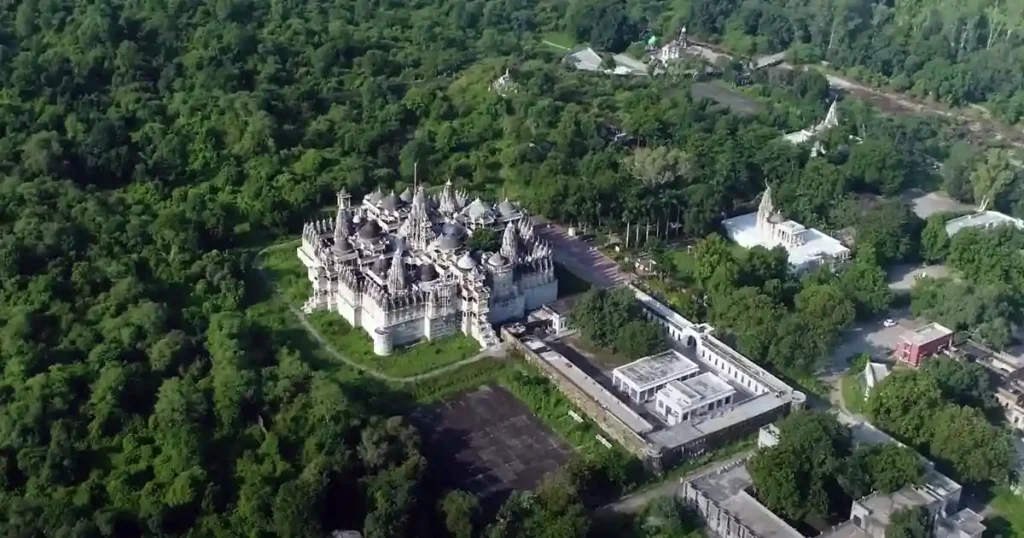
Kumbhalgarh Fort timings:
The Kumbhalgarh Fort timing is from 9:00 AM to 6:00 PM, all days of the week throughout the year.
Kumbhalgarh Fort ticket price:
Kumbhalgarh Fort ticket price for domestics and visitors of SAARC (Sri Lanka, Pakistan, Bangladesh, Nepal, Bhutan, Afghanistan, and Maldives) and BIMSTEC Countries (Nepal, Bhutan, Bangladesh, Sri Lanka, Myanmar and Thailand) – Rs. 40 per head. For other foreigners, the Kumbhalgarh Fort ticket price is Rs.600. For children below the age of 15 entry is free.
Kumbhalgarh Wildlife Sanctuary Jeep Safari
The trail through Kumbhalgarh Wildlife Sanctuary offers a good jungle experience, though the ride can be extremely bumpy. During the safari, you might spot some monkeys, wild boars, deer, and many more.
Kumbhalgarh Wildlife Sanctuary Jeep Safari Price Details: Please note that prices may change.
Price for 6 Adults: ₹4550 (includes a guide)
Gypsy Safari: Permitted by the forest department except during the monsoon season.
- Cost for 1 Gypsy (5/6 persons): ₹4215
- Pick Up & Drop to Resort: ₹400
Activity Information:
- Location: Kumbhalgarh Sanctuary Entry Point
- Morning Slot: Between 6:00 AM to 9:00 AM
- Evening Slot: Between 2:30 PM to 4:00 PM
- Distance Covered: 22 KM (Up & Down)
- Duration: 2.5 to 3 Hours
Kumbhalgarh Wildlife Sanctuary Photo
Kumbhalgarh Wildlife Sanctuary has many beautiful scenarios to shoot photos. Many films shooting is carried out at Kumbhalgarh Fort. The well-known Kumbhalgarh Fort is surrounded all around by the Sanctuary. Kumbhalgarh Wildlife Sanctuary has many scenic locations perfect for film shooting.
Entry Fee Kumbhalgarh Wildlife Sanctuary
Since October 1999, an entry fee has been charged to visitors as per State Government orders. Kumbhalgarh Wildlife Sanctuary ticket price is ₹75 on weekdays and ₹100 on weekends.
Kumbhalgarh Wildlife Sanctuary timings
Kumbhalgarh Wildlife Sanctuary is open from 7:00 AM to 6:00 PM throughout the week. Canteens are available for tea and coffee only, and washrooms are available for both men and women.
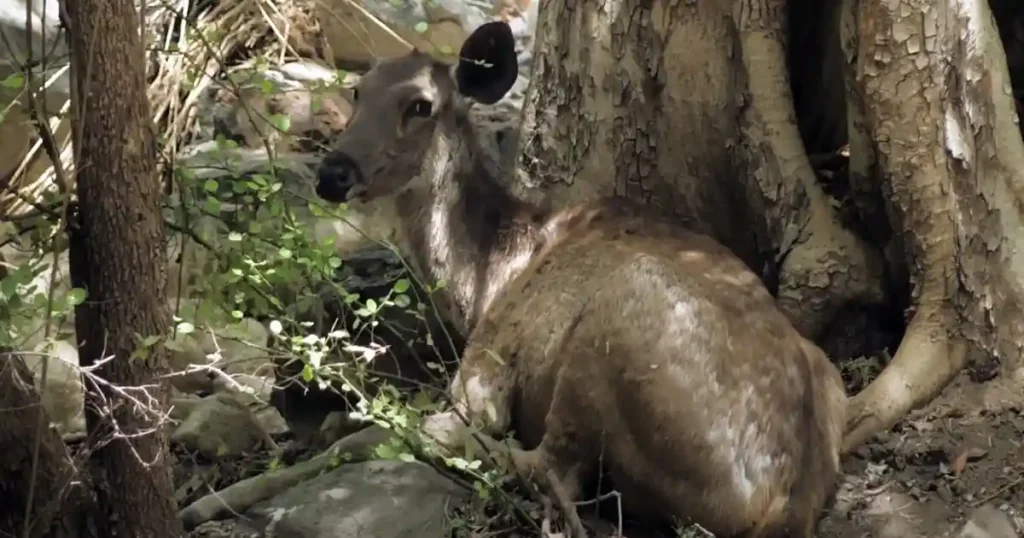
Best Time to visit Kumbhalgarh Wildlife Sanctuary
The best time to visit Kumbhalgarh Wildlife Sanctuary is from October to March. The weather during this time is pleasant, making it perfect for exploring.
Kumbhalgarh Wildlife Sanctuary, located in the Aravalli Range near the Thar Desert, has a semi-dry climate like much of Rajasthan. From March to June, it gets extremely hot, sometimes over 40°C (104°F), with temperatures often rising above 30°C and can even reach up to 48°C.
The monsoon season runs from July to September, bringing most of the annual rainfall, which is crucial for the sanctuary’s plants and animals. The average annual rainfall is around 725mm, with a maximum of 950mm and a minimum of 403mm, varying across the hills and valleys.
During winter, from November to February, the weather is mild and enjoyable, with temperatures ranging from 10°C to 25°C (50°F to 77°F). Many tourists prefer this time to visit and experience the sanctuary’s cooler climate.
So, if you want to enjoy your visit without the extreme heat or rain, visit between October and March.
How to Reach Kumbhalgarh Wildlife Sanctuary
One can reach Kumbhalgarh Wildlife Sanctuary by either public or private transportation, both of which are easily available and accessible in the nearby regions.
- Nearest Airport: Udaipur Airport is the closest, located 85 km away. Domestic flights from major cities are available to Udaipur.
- Nearest Railway Station: Udaipur Railway Station is 85 km away. Trains from major cities reach Udaipur.
- Nearest Bus Stand: Sadri Bus Stop is 85 km away. Buses from Udaipur are available to Kumbhalgarh Wildlife Sanctuary.
Where to Stay?
There are many Forests Rest houses inside and around the Sanctuary. The Forest Rest Houses at Roopanmata, Thandi Beri, Sumer, Sadri, and Ranakankar, provide serene stays amidst nature, and can enjoy watching wildlife beside picturesque Aravalli hill ranges.
There are lots of luxury and budget hotels also around the sanctuary of privates such as RTDC Ranakpur. For those seeking religious and cultural experiences, Temple Rest Houses at Bijapur and Rata Mahaveer are available.
Conclusion
Kumbhalgarh Wildlife Sanctuary, situated along 85 km of the western face of the Aravalli Hills in south-central Rajasthan, covering 610.53 sq. km across parts of three districts: Rajsamand, Udaipur, and Pali, serves as an ecotone between the Aravalli Hills and the Thar Desert. The Kumbhalgarh Fort, located within the sanctuary along with Parashram Mahadev Temple, Muchala Mahavir Jain Temple, Ranakpur Jain Temple, etc. further increases the significance of this sanctuary.
There are 24 villages within the Kumbhalgarh Wildlife Sanctuary and 138 villages in its influence zone. The Raika, or Rebari, are Western India’s largest pastoralist community, herding sheep, goats, and cattle, and maintaining close ties with camels within these areas.
Visiting Kumbhalgarh Wildlife Sanctuary is an amazing chance to see a variety of animals, as it is an ideal habitat for Carnivores, Herbivores, and a variety of arboreal and water birds. The Sanctuary can be explored by taking a jeep safari or trekking. The best time to visit Kumbhalgarh Wildlife Sanctuary is from October to March.
FAQ
a) What is Kumbhalgarh Wildlife Sanctuary famous for?
Kumbhalgarh Wildlife Sanctuary is famous for the Great Wall of India, Kumbhalgarh Fort, a UNESCO World Heritage Site, from which the sanctuary derives its name. It is also famous as a natural home to numerous wild animals and more than 200 species of terrestrial, arboreal, and water birds.
b) How to visit Kumbhalgarh Wildlife Sanctuary?
To visit Kumbhalgarh Wildlife Sanctuary, one needs to take a Jeep safari permitted by the forest department. The safari offers a good jungle experience, though the ride can be extremely bumpy. It covers 22 KM (up & down) from the Kumbhalgarh Sanctuary Entry Point and takes 2.5 to 3 hours.
c) What is the entry fee for Kumbhalgarh Wildlife Sanctuary?
The entry fee for Kumbhalgarh Wildlife Sanctuary price is ₹75 on weekdays and ₹100 on weekends. Since October 1999, an entry fee has been charged to visitors as per State Government orders.
d) What animals are in the Kumbhalgarh forest?
The major animals found in the sanctuary are Wolf, Wild Boar, Sloth Bear, Leopard, Indian Hare, Four Horned Antelope, Fox, Grey Jungle Fowl, Wild Cat, Jackal, Porcupine, Blue Bull, Hyaena, Civet, Sambar, Langur, Mongoose, Chinkara, Crocodile, and more. The area of Kumbhalgarh Wildlife Sanctuary provides an ideal habitat for herbivores, carnivores, as well as a variety of arboreal and water birds.
e) The relevance of Kumbhalgarh Wildlife Sanctuary UPSC examinations:
Kumbhalgarh Wildlife Sanctuary was notified as a Wildlife Sanctuary on 13th July 1971. The Sanctuary covers 610.528 sq. km area and is located in south-central Rajasthan spread over three districts namely Udaipur, Rajsamand, and Pali. The Kumbhalgarh Fort falls within the Kumbhalgarh Wildlife Sanctuary from which the sanctuary got its name.
You May Also Like

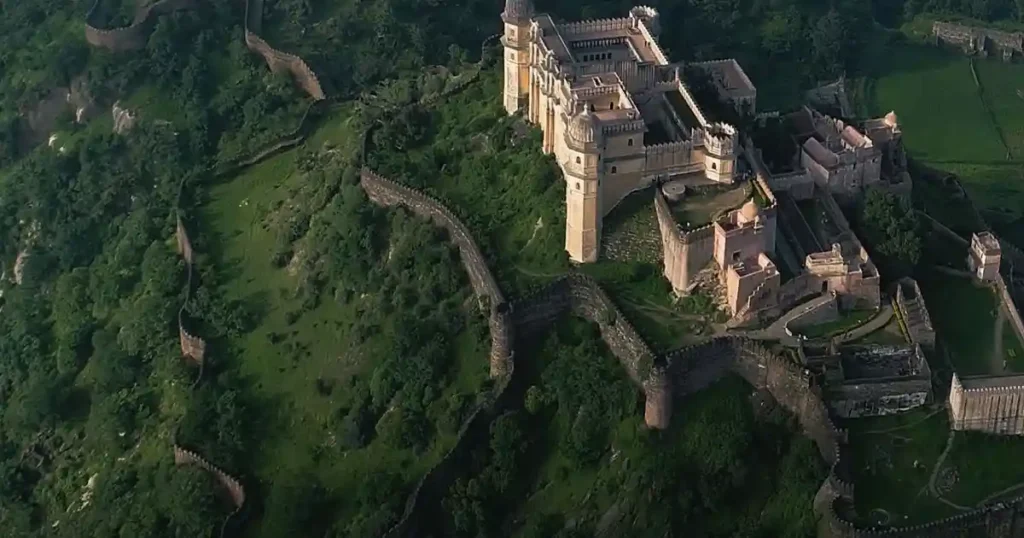
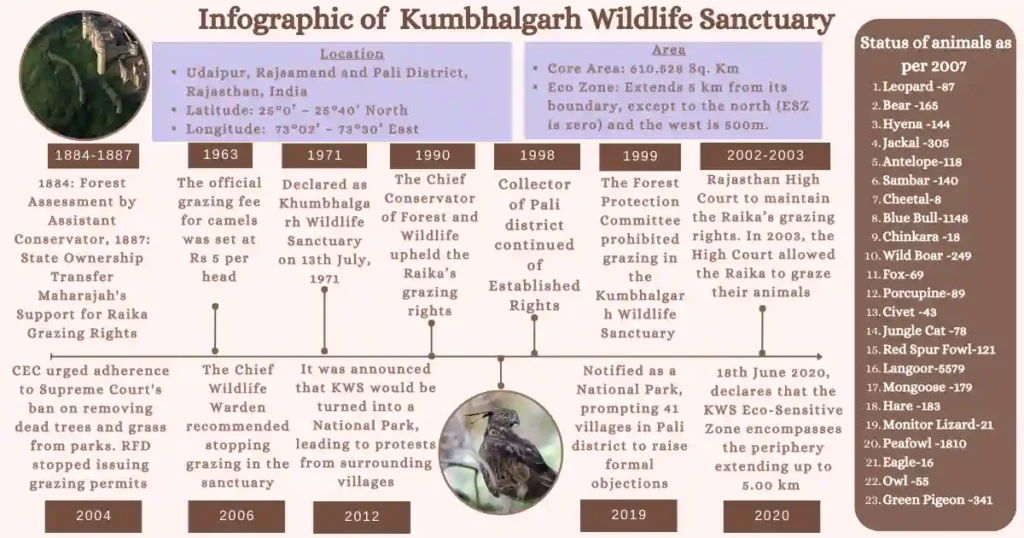
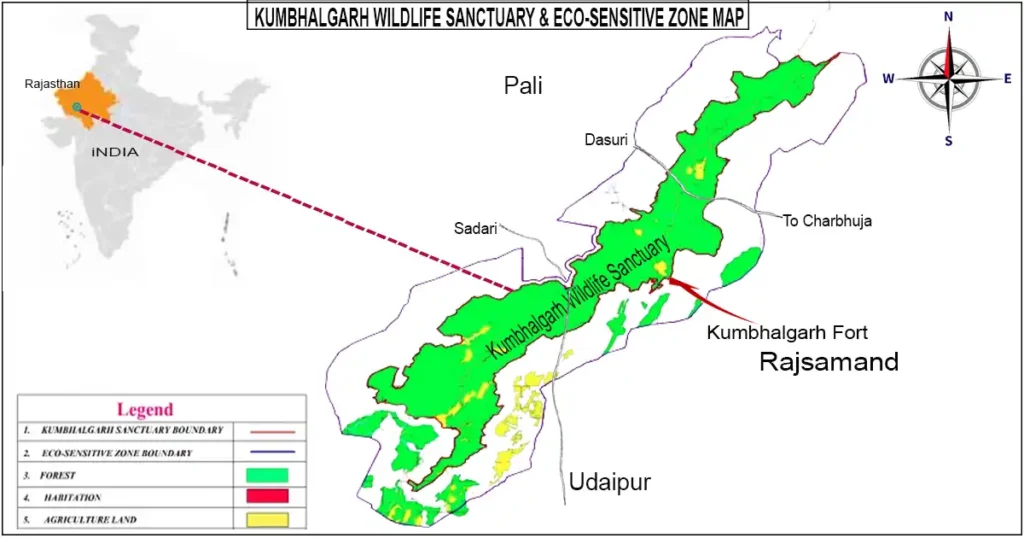


1 thought on “Kumbhalgarh Wildlife Sanctuary”